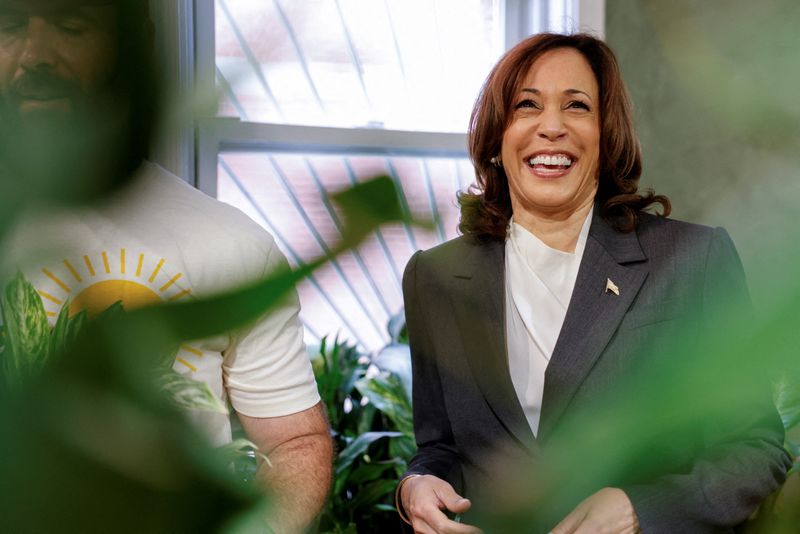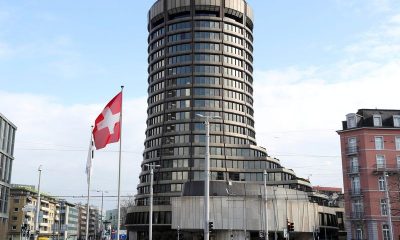Economy
VP Harris to celebrate new rules boosting wages, protections on federal projects


© Reuters. FILE PHOTO: U.S. Vice President Kamala Harris?smiles as she stops at Rewild, a plant shop in the Historic Eastern Market, during a tour of small businesses on Jobs Day in Washington, U.S., August 4, 2023. REUTERS/Kevin Wurm/File Photo
By Jarrett Renshaw
PHILADELPHIA (Reuters) – The Biden administration will bolster union-friendly rules on Tuesday that will boost wages and protections for workers on federally funded construction projects, potentially drawing the ire of trade groups who warn the changes could curtail billions of dollars in new federal investment.
Vice President Kamala Harris will visit Philadelphia on Tuesday to celebrate the new labor reforms at a union hall. The trip marks the latest in a string of visits by Harris and President Joe Biden to this key electoral battleground state to court unions, a core constituency.
The changes to the Davis-Bacon Act issued by the Labor Department seek to boost wages and protections as the federal government spends billions of dollars on new roads and bridges, and expanding industries like computer chips and green energy spurred by several pieces of legislation.
“The rules are more important than ever to ensure fair wages for workers and ensuring good wages for them,” a senior administration official said.
The Davis-Bacon Act, first established in 1931, tasks the federal government with establishing wage floors – known as prevailing wages – that apply to construction projects partially or fully funded by the federal government. It applies to more than one million construction workers on $200 billion of such projects, the administration said.
President Joe Biden ordered the review of the labor law early in the administration and the Labor Department proposed the rule in March last year. It will become effective in roughly 60 days.
Trade groups have long criticized the prevailing wage requirements under the Davis-Bacon Act, saying they are burdensome and discourage small businesses from seeking federal contracts.
The rule changes the way prevailing wages are calculated, basing them on wages paid to at least 30% of local workers, rather than a 50% threshold set in 1983 by then-President Ronald Regan.
The prevailing wage rate is based on an average rate in a region, and eliminating some lower-wage workers in the calculation will boost the wage floor, a senior administration official said.
The Labor Department must currently periodically survey contractors and other parties to update prevailing wage rates, but will now be able to adopt prevailing wages determined by state and local governments, issue wage determinations for jobs when data is lacking and update outdated wage rates.
The rule will add a new anti-retaliation provision in contract clauses to protect workers who raise concerns from being fired or punished and strengthens the government’s ability to withhold money from a contractor in order to pay employees their lost wages.
Economy
Russian central bank says it needs months to make sure CPI falling before rate cuts -RBC


© Reuters. Russian Central Bank Governor Elvira Nabiullina attends a news conference in Moscow, Russia June 14, 2019. REUTERS/Shamil Zhumatov/File Photo
MOSCOW (Reuters) – Russia’s central bank will need two to three months to make sure that inflation is steadily declining before taking any decision on interest rate cuts, the bank’s governor Elvira Nabiullina told RBC media on Sunday.
The central bank raised its key interest rate by 100 basis points to 16% earlier in December, hiking for the fifth consecutive meeting in response to stubborn inflation, and suggested that its tightening cycle was nearly over.
Nabiullina said it was not yet clear when exactly the regulator would start cutting rates, however.
“We really need to make sure that inflation is steadily decreasing, that these are not one-off factors that can affect the rate of price growth in a particular month,” she said.
Nabiullina said the bank was taking into account a wide range of indicators but primarily those that “characterize the stability of inflation”.
“This will take two or three months or more – it depends on how much the wide range of indicators that characterize sustainable inflation declines,” she said.
The bank will next convene to set its benchmark rate on Feb. 16.
The governor also said the bank should have started monetary policy tightening earlier than in July, when it embarked on the rate-hiking cycle.
Economy
China identifies second set of projects in $140 billion spending plan


© Reuters. FILE PHOTO: Workers walk past an under-construction area with completed office towers in the background, in Shenzhen’s Qianhai new district, Guangdong province, China August 25, 2023. REUTERS/David Kirton/File Photo
SHANGHAI (Reuters) – China’s top planning body said on Saturday it had identified a second batch of public investment projects, including flood control and disaster relief programmes, under a bond issuance and investment plan announced in October to boost the economy.
With the latest tranche, China has now earmarked more than 800 billion yuan of its 1 trillion yuan ($140 billion) in additional government bond issuance in the fourth quarter, as it focuses on fiscal steps to shore up the flagging economy.
The National Development and Reform Commission (NDRC) said in a statement on Saturday it had identified 9,600 projects with planned investment of more than 560 billion yuan.
China’s economy, the world’s second largest, is struggling to regain its footing post-COVID-19 as policymakers grapple with tepid consumer demand, weak exports, falling foreign investment and a deepening real estate crisis.
The 1 trillion yuan in additional bond issuance will widen China’s 2023 budget deficit ratio to around 3.8 percent from 3 percent, the state-run Xinhua news agency has said.
“Construction of the projects will improve China’s flood control system, emergency response mechanism and disaster relief capabilities, and better protect people’s lives and property, so it is very significant,” the NDRC said.
The agency said it will coordinate with other government bodies to make sure that funds are allocated speedily for investment and that high standards of quality are maintained in project construction.
($1 = 7.1315 renminbi)
Economy
Russian central bank says it needs months to make sure CPI falling before rate cuts -RBC


© Reuters. Russian Central Bank Governor Elvira Nabiullina attends a news conference in Moscow, Russia June 14, 2019. REUTERS/Shamil Zhumatov/File Photo
MOSCOW (Reuters) – Russia’s central bank will need two to three months to make sure that inflation is steadily declining before taking any decision on interest rate cuts, the bank’s governor Elvira Nabiullina told RBC media on Sunday.
The central bank raised its key interest rate by 100 basis points to 16% earlier in December, hiking for the fifth consecutive meeting in response to stubborn inflation, and suggested that its tightening cycle was nearly over.
Nabiullina said it was not yet clear when exactly the regulator would start cutting rates, however.
“We really need to make sure that inflation is steadily decreasing, that these are not one-off factors that can affect the rate of price growth in a particular month,” she said.
Nabiullina said the bank was taking into account a wide range of indicators but primarily those that “characterize the stability of inflation”.
“This will take two or three months or more – it depends on how much the wide range of indicators that characterize sustainable inflation declines,” she said.
The bank will next convene to set its benchmark rate on Feb. 16.
The governor also said the bank should have started monetary policy tightening earlier than in July, when it embarked on the rate-hiking cycle.

 Forex3 years ago
Forex3 years agoForex Today: the dollar is gaining strength amid gloomy sentiment at the start of the Fed’s week

 Forex3 years ago
Forex3 years agoUnbiased review of Pocket Option broker

 Forex3 years ago
Forex3 years agoDollar to pound sterling exchange rate today: Pound plummeted to its lowest since 1985

 Forex3 years ago
Forex3 years agoHow is the Australian dollar doing today?

 Cryptocurrency3 years ago
Cryptocurrency3 years agoWhat happened in the crypto market – current events today

 World3 years ago
World3 years agoWhy are modern video games an art form?

 Commodities3 years ago
Commodities3 years agoCopper continues to fall in price on expectations of lower demand in China

 Economy3 years ago
Economy3 years agoCrude oil tankers double in price due to EU anti-Russian sanctions

























